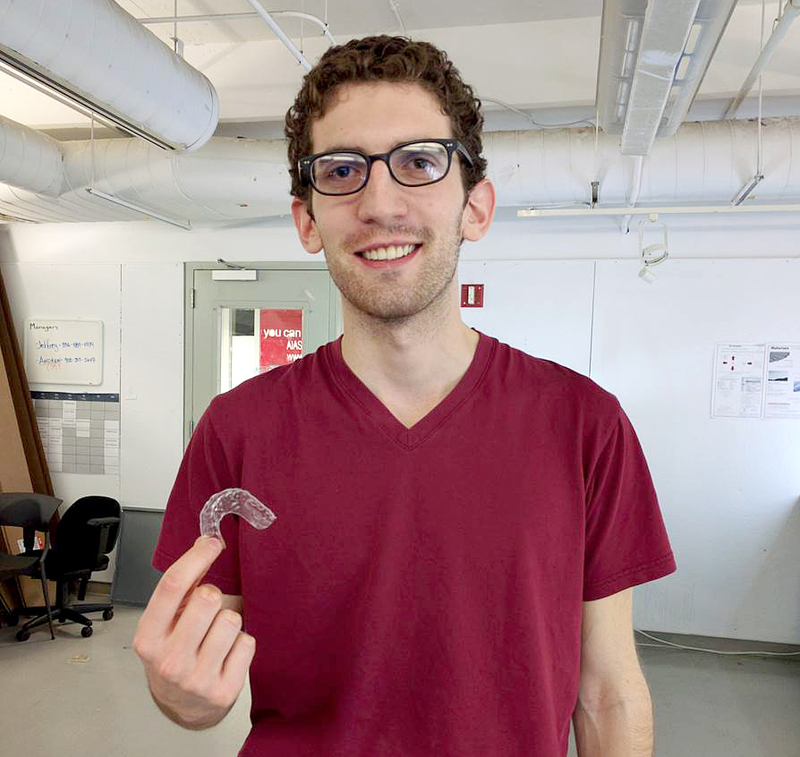 i
iA box of 3-D models 24-year-old student Amos Dudley made of his teeth. The model labeled "3" rests on a 3-D-printed tray Dudley made to make impressions of his teeth with a putty-like material. Also in the box are a clear plastic aligner and other 3-D models used to make more aligners, each one pushing the problematic teeth further into place. Jon Kalish for NPR hide caption

A box of 3-D models 24-year-old student Amos Dudley made of his teeth. The model labeled "3" rests on a 3-D-printed tray Dudley made to make impressions of his teeth with a putty-like material. Also in the box are a clear plastic aligner and other 3-D models used to make more aligners, each one pushing the problematic teeth further into place.
Jon Kalish for NPRA college student in New Jersey, tired of his crooked teeth, decided to fix them — all by himself, using a 3-D printer and other digital fabrication tools.
Amos Dudley is about to graduate from the New Jersey Institute of Technology with a degree in digital design. The 24-year-old is a self-described hard core geek with a passion for 3-D printing. So it was this technology he turned to when he decided he wanted to straighten his teeth.
Dudley had the idea to make a series of dental devices known as aligners using one of the 3-D printers at the college. After consulting a couple of orthodontics texts, he got started. First he took some old school impressions of his teeth with a putty-like material he bought online.
"I pretty much read the instructions on the back of the bag," he recalls.

Dudley used a 3-D printer to create dental aligners to straighten his crooked teeth. Jon Kalish for NPR hide caption
Then he got seriously high-tech. Dudley used a laser scanner to turn the plaster model he'd made into a digital replica. He used 3-D modeling software and mathematical calculations to figure out how to move his problematic teeth into place. Finally, he made a dozen aligners by melting thin sheets of plastic over the 3-D models of his teeth.
"I basically would wear them between one and three weeks each," he says. "I sort of knew to stop wearing a retainer when they no longer felt like they were exerting pressure on my teeth."
How do orthodontists feel about this?
Dr. Richard Bloomstein, a professor of orthodontics at the Rutgers School of Dental Medicine, says he was both shocked and impressed.
"Did it work as well as an orthodontist might have done it?" he says. "Maybe."
But Bloomstein says the outcome of this amateur orthodontics might've been different if there was decay or bone disease near the teeth Dudley was manipulating,
"Certain things are not a bargain, even if they're cheaper," he says. "I would not look for bargains in parachutes. Likewise, bargains in health care."
Shots - Health News
Doctors Use 3-D Printing To Help A Baby Breathe
Shots - Health News
Print Me An Ear: 3-D Printing Tackles Human Cartilage
Shots - Health News
3-D Printer Brings Dexterity To Children With No Fingers
But traditional orthodontic care is expensive — often thousands of dollars — one reason online services that offer budget dental aligners and don't require office visits seem to be gaining popularity. Patients need only to send in impressions and smartphone photos of their teeth.
Dudley didn't realize he tapped into a market, but he's pretty happy with the way things have turned out.
"I had no idea if this was going to work. It probably only worked in large part because of luck and good initial conditions," he says. "But if there's an idea you have, you just have to try it out. I mean, I had the idea and I went with it, so the outcome was sort of the best I could hope for I guess."
Dudley says he's received hundreds of request to make dental aligners and one suggestion from an orthodontist that they go into business together. But he says he has no interest in any of that.
Instead, he's going to work for a 3-D printer manufacturer. The company offered him a job after hearing of his dental handiwork.
Source → New Jersey Student Uses 3-D Printer For DIY Dental Work
